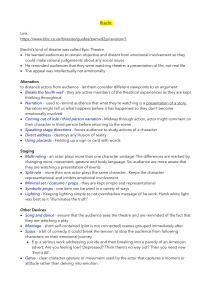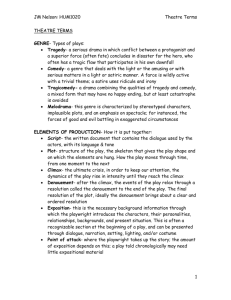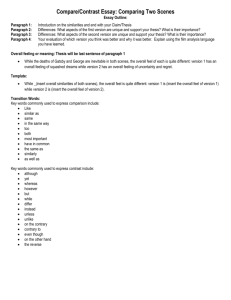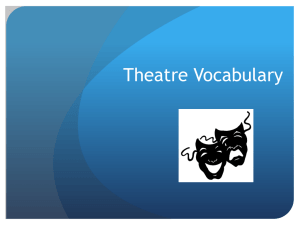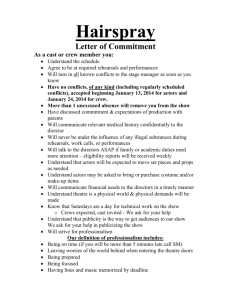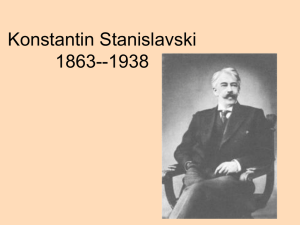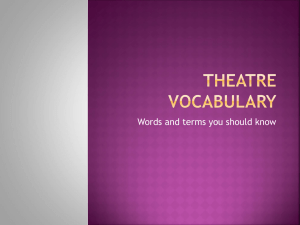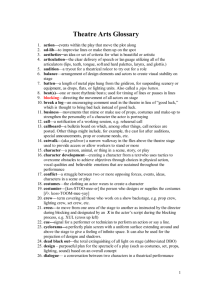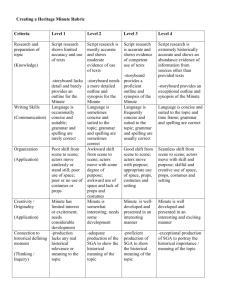Short Drama Vocab List
advertisement
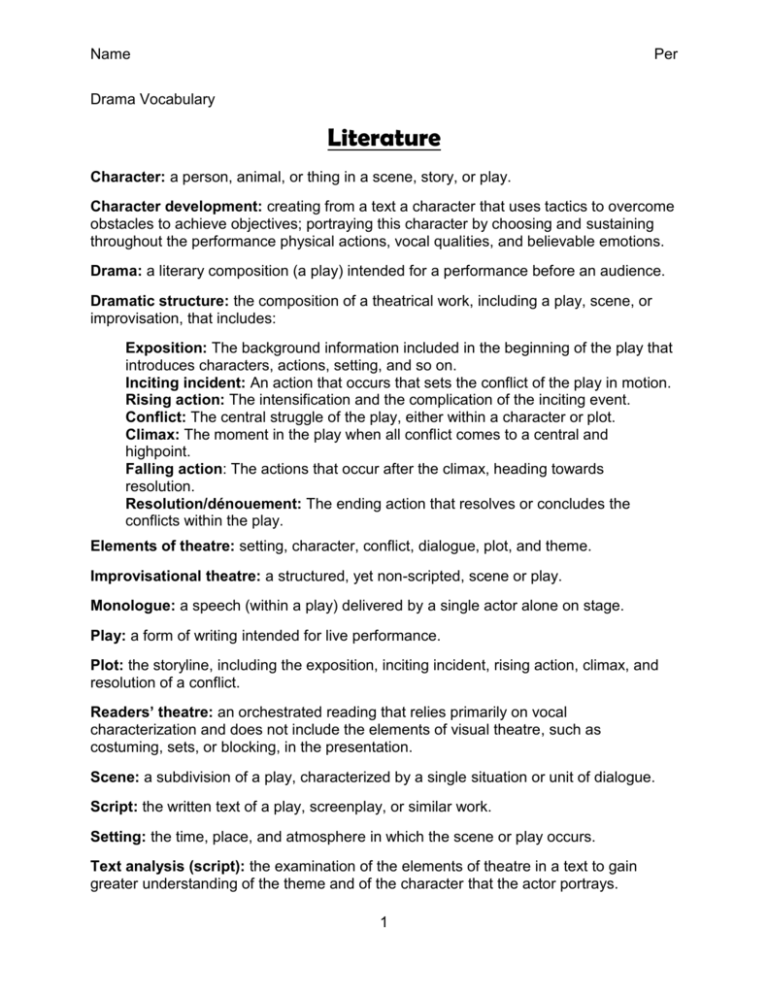
Name Per Drama Vocabulary Literature Character: a person, animal, or thing in a scene, story, or play. Character development: creating from a text a character that uses tactics to overcome obstacles to achieve objectives; portraying this character by choosing and sustaining throughout the performance physical actions, vocal qualities, and believable emotions. Drama: a literary composition (a play) intended for a performance before an audience. Dramatic structure: the composition of a theatrical work, including a play, scene, or improvisation, that includes: Exposition: The background information included in the beginning of the play that introduces characters, actions, setting, and so on. Inciting incident: An action that occurs that sets the conflict of the play in motion. Rising action: The intensification and the complication of the inciting event. Conflict: The central struggle of the play, either within a character or plot. Climax: The moment in the play when all conflict comes to a central and highpoint. Falling action: The actions that occur after the climax, heading towards resolution. Resolution/dénouement: The ending action that resolves or concludes the conflicts within the play. Elements of theatre: setting, character, conflict, dialogue, plot, and theme. Improvisational theatre: a structured, yet non-scripted, scene or play. Monologue: a speech (within a play) delivered by a single actor alone on stage. Play: a form of writing intended for live performance. Plot: the storyline, including the exposition, inciting incident, rising action, climax, and resolution of a conflict. Readers’ theatre: an orchestrated reading that relies primarily on vocal characterization and does not include the elements of visual theatre, such as costuming, sets, or blocking, in the presentation. Scene: a subdivision of a play, characterized by a single situation or unit of dialogue. Script: the written text of a play, screenplay, or similar work. Setting: the time, place, and atmosphere in which the scene or play occurs. Text analysis (script): the examination of the elements of theatre in a text to gain greater understanding of the theme and of the character that the actor portrays. 1 Theater or theatre: 1. the place where plays are presented to an audience; 2. the art of creating performances. Theatre etiquette: the appropriate behavior of an audience, performers, or technicians in a variety of settings. Theme: the central idea of a play. Acting Acting skills: the use of voice, movement, improvisation, and characterization. Articulation: the use of all of the articulators (lips, teeth, tongue, soft and hard palettes, larynx, and glottis) to deliver speech or language clearly. Blocking: an actor’s traffic pattern on stage. Business: movements that mime or make use of props, costumes, and make-up to strengthen the personality of the character the actor is portraying. Dialogue: a conversation between two characters in a theatrical performance. Ensemble: a group of actors who work together cooperatively and responsibly to achieve the group’s goal by means of problem solving and creativity. Enunciation: saying the vowels and consonants correctly. Expression: the way a character says words to convey meaning and emotion. Gestures: the movement of a body part (arm, leg, hand, etc.) to communicate. Given circumstance: in the text of a play, the information the playwright gives concerning character, setting, and relationships. Improvisation: a spontaneous performance during which the actors establish a story (including objectives, setting, characters, and relationships) with minimal preparation. Level: 1. the placement of an object or person on the stage from upstage to downstage; 2. the vertical height of an actor or set piece as measured from the stage floor. Mime: to act out movement or portray a character without speaking or using props (totally silent). Movement: a physical action used to establish meaning and emotion in order to create a character. 2 Name Per Objective: a character’s wants, needs, and desires. Obstacle: something that stands in the way of the character achieving his/her objectives. Open: a body position in which the character’s face and body can be seen by the audience when the character stands on a proscenium or thrust stage. Pantomime: the conveying a story by using expressive body and facial movements, but without using speech, props, costumes or sounds (instrumental music can be used as background). Performance: a structured presentation of a theatrical work in front of an audience. Posture/stance: the position of the limbs and the carriage of the body as a whole that communicate character. Projection/volume: the appropriate use of loud and soft sounds to convey meaning and emotion to the entire audience. Pronunciation: the correct way to speak or articulate a word. Rehearsal: the period of time used to prepare a play for performance before an audience. Tactics: the possible ways the character can overcome obstacles. Voice: vocal qualities that are used to convey meaning and emotion in order to create character. 3 Technical Design Aesthetics: an idea of what is beautiful or artistic; a set of criteria for judging something beautiful or artistic. Balance: the arrangement of design elements and actors to create visual stability on stage. Costumes: the clothing an actor wears to create a character. Cue: 1. a signal for a performer or technician to perform an action or say a line; 2. a signal from a side-coach to perform an action or say a line. Design: a purposeful plan, based on an overall concept, for the spectacle of a play. Lighting: the use of a variety of instruments to illuminate both the actors and sets on stage. Make-up: cosmetics applied to the face and body to enhance character. . Props/properties: objects used by an actor on stage. Proscenium: the part of a modern stage in front of the curtain; the foreground. Set: the space on a stage and the structures of this space (scenery) that represents the setting of the play and in which the actors perform. Sound: the process of using music, audio effects, and reinforcement to enhance the setting and mood. Stage: the place where the actors perform. Stage geography: the physical areas of the stage labeled center stage, down center, up center, stage right, stage left, up stage left, down stage left, up stage right, and down stage right. Stage picture: a visual image created by using any combination of set, costume, props, lighting, and character placement. Venue: a place where a performance is held. 4

